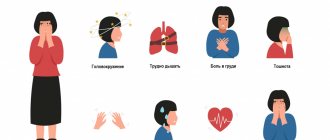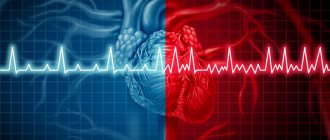Panic attacks and symptoms
Quite often, panic disorder is disguised as other diseases, which makes it difficult to quickly diagnose the disease. Patients experience the same sensations that appear in real neurological, cardiovascular and other serious pathologies.
A person who has recently experienced panic disorder, as a rule, does not know about it, so he often turns to doctors of various specializations for help. The patient is prescribed various examinations of the body, and in the end it turns out that he has no pathologies of internal organs, but despite this, the symptoms of a non-existent disease continue, even intensifying over time. In this case, we can talk about the presence of a panic attack or panic disorder.
Signs of a panic attack
The signs of this disease in most cases have a pronounced physical characteristic; the symptoms are similar to a heart attack, so many patients suspect heart pathology. However, even strong vegetative manifestations in this case are a consequence of dysfunctions of the nervous system and brain.
The main symptoms of a panic attack are anxiety attacks, which are accompanied by autonomic disorders (rapid heartbeat, chills, sweating). With an increase in the level of anxiety, the physiological parameters of the body, which are situational in nature, are often disrupted.
The severity of anxiety varies from a state of internal tension to pronounced panic and fear of death. The average duration of an attack is 15-30 minutes. Anxiety reaches its maximum in the first 5-10 minutes and goes away as suddenly as it started.
Sometimes a panic attack develops against the background of situations that are uncomfortable for a person: being in a crowd or in a confined space.
For some people, attacks occur several times a day, for others - 1-2 times a month. Panic attacks often occur during the daytime. At night, anxiety attacks are more likely to bother strong-willed people who control their feelings while awake.
Vegetovascular dystonia: what is it and how to treat it?
“All diseases come from nerves...” Everyone knows this common phrase. Someone will agree with this, someone will laugh and say that psychiatrists would like it that way. However, it is difficult to deny that mental factors greatly influence well-being. Fatigue, pale appearance, dizziness, tinnitus - this set of symptoms is often combined with the diagnosis of “vegetative-vascular dystonia”. What kind of disease is this? How to treat it? What factors influence our well-being? Is it possible to get rid of weather sensitivity? What is the “placebo effect” and why should you not get carried away with physical procedures? You can read about this and much more in an interview with a professional in somatic medicine, Candidate of Medical Sciences, Associate Professor of the Department of Faculty Therapy No. 1 of the First Moscow State Medical University. I. M. Sechenov Anton Vladimirovich Rodionov.
— What is vegetative-vascular dystonia? Is this a disease or a syndrome?
- Neither one nor the other. Vegetative-vascular dystonia is a kind of “garbage dump”, which contains a huge number of symptoms that the doctor, as a rule, does not really want to deal with. This includes a variety of conditions, ranging from “oh, mom, boys don’t like me,” to severe mental and neurological diseases. This disease is not included in the International Classification of Diseases (ICD); it was invented by “Soviet scientists.” And it’s not bad that it’s made up, the trouble is that often behind this pseudo-diagnosis lie completely understandable, recognizable diseases that can and should be treated. Instead, patients are often offered a huge range of dubious treatment methods with unproven effectiveness.
— When did this diagnosis appear? Why, as you say, was it invented?
— This diagnosis is already 100 years old, if not more. It first appeared in American literature back in the 19th century, but only in Soviet-Russian medicine did it manage to survive until the 3rd millennium. Medicine is developing very quickly and it is quite natural that once upon a time approaches to treatment and diagnosis formulations were completely different. Today, for example, it would never occur to anyone to formulate such a diagnosis as “intestinal catarrh.” It is also time for the diagnosis of VSD to take pride of place in the textbook on the history of medicine.
- Well, then let’s talk, if not about the disease (since it doesn’t exist), then about the symptom complex. What can provoke these conditions, which are collectively referred to as VSD.
— Those patients who are diagnosed with VSD in Russia should, as a rule, be observed by psychotherapists, and sometimes by psychiatrists and neurologists. Because most often these are patients who suffer from neurotic disorders - panic attacks, fears, and so on.
— What are the reasons for the development of these disorders?
- In fact, this question comes down to what causes neuroses. On the one hand, they may be based on hereditary factors, on the other hand, they may be due to external reasons, mainly stress. But this is only one side of the issue. Quite often, under the mask of VSD, diseases are hidden, which, as I have already said, can be recognized and successfully treated. For example, it could be iron deficiency anemia. A decrease in hemoglobin leads to tachycardia, heart pain, shortness of breath and other symptoms of cardiovascular disease. Some diseases of the endocrine system, such as thyrotoxicosis, have similar manifestations. And it’s very bad when, instead of prescribing a patient to test for iron, thyroid-stimulating hormone, and so on, they begin to treat him in an unclear way.
— There are about 40 symptoms of VSD in the literature...
- I think there are many more of them. (Smiles.)
— Could you list some of them?
— It is difficult to list the symptoms of a disease that does not exist. However, this diagnosis is often given to patients with complaints of palpitations, indistinct piercing pains in the heart, fainting, general weakness, and so on.
- Be that as it may, today doctors quite often make this diagnosis to their patients.
— We have a lot of problems... Dysbacteriosis alone is worth it. Unfortunately, this is a systemic learning problem. Many doctors do not strive to constantly monitor the latest achievements of world science. As they were taught at the institute in the 60s - 80s, this is how they treat. We always tell patients with a referral diagnosis of VSD: “Find another doctor, it is useless to be treated by this specialist.” Another such moment. For some reason, we believe that a doctor must make a diagnosis.
- Is not it so?
“One of my senior colleagues once wrote the following phrase in her medical history: “He’s healthy, he doesn’t need treatment.” Few modern specialists will take it upon themselves to make such a recording. And it’s not a matter of responsibility, it’s just that there is no such habit. For example, a patient comes to an appointment with a complaint that his pulse is 95 beats per minute. And I can afford to say: “This is your version of the norm. You are healthy and there is no need to treat you.” How are these standards calculated? For example, 10 thousand clinically healthy people are taken, some indicator is measured from them (in this case, heart rate), and then 2.5% of the percentage is “bitten off” on each side. Thus, 95% of people fall into a certain range (from 60 to 85 beats/min), which is called the norm. But the remaining 2.5% on the right and left, who live with a pulse of 55 and 95 beats/min, are also healthy! And the doctor’s task is to understand this situation and draw the right conclusions. Of course, tachycardia can be a symptom of various diseases - arrhythmia, thyrotoxicosis, anemia, pulmonary failure, neurotic disorders, including depression.
— What happens in a person with a neurotic disorder?
- Let's first figure out in what case a healthy person needs to increase the pulse rate and increase blood pressure. Tachycardia normally occurs when it is necessary to respond to an external stimulus, for example, to run away from danger. In this situation, the muscles need more blood, therefore the heart must increase its heart rate. But when the danger passes, the pulse returns to normal. A patient with a neurotic disorder is outwardly calm, no one is chasing him, he does not need to catch up with anyone. But the brain gives a signal: “You are in danger, run away!”, and this whole cascade of reactions that I talked about is launched. And in this case, treating tachycardia as a symptom is at least absurd; the disease itself must be treated. And such patients should be managed not by a cardiologist or a therapist, but by a psychiatrist or psychotherapist.
— Should you also see a psychiatrist for cardioneurosis?
- Yes. In fact, this is also a neurotic disorder with certain “cardiological” manifestations. Nowadays the diagnosis is not formulated this way; this is also a “legacy” from the 50s and 60s. last century.
- Sorry, but this diagnosis is also often made in our clinics...
“First of all, this is due to the fact that in our country we do not have a properly functioning system of postgraduate education for doctors. Naturally, there are certification courses that a doctor must attend once every five years, but what he does there is his own business; no one seriously controls this process. And I don’t know a single doctor who, after five years, would not be able to confirm his certificate.
— When you talk about insufficient professional competence, then, as far as I understand, we are talking about doctors of the older generation?
“Fortunately, we see such diagnoses less and less often. And I am sure that my students will not write such a diagnosis with their own hands. And, probably, they will continue to teach someone. So I look into the future with a certain degree of optimism.
— Let's return to the VSD. What should patients do if their doctor has given this diagnosis? Who can help them?
— You cannot equate the absence of a diagnosis as such with the absence of a disease in a person. If I say that the diagnosis of VSD is fictitious and does not exist, this does not mean at all that I consider this patient to be a malingerer. First of all, it must be carefully examined. But it also happens that you just need to talk to the patient and understand that his “VSD” is the result of loneliness and some kind of complexes. And also to the question of “schools”. My teachers (they, unfortunately, have already passed away), Corresponding Member of the Russian Academy of Medical Sciences Vladimir Ivanovich Makolkin and Doctor of Medical Sciences Stanislav Alekseevich Abbakumov, dealt with patients with similar disorders, they formulated such a condition as “neurocirculatory dystonia”, in the 80s - 90s ‑e years of the last century this was the scientific topic of our department. As a result of this work, a wonderful psychosomatic center was created at the clinic, and such patients still come to us. But in the 21st century, we no longer allow ourselves to diagnose VSD; we do not treat them with adaptogens and physiotherapy, but refer them to specialized specialists, from whom they receive adequate psychotherapeutic and sometimes psychiatric help. Our clinic employs a wonderful team of psychotherapists who are well aware of the approaches to these patients.
— What are psychosomatic disorders?
— Initially, these are diseases of the central nervous system, which manifest themselves as somatic, that is, bodily complaints. Often these people go from one specialist to another for years with a variety of complaints. Very often, these symptoms disguise “somatized depression.” Every year there are more and more such patients. If the patient understands that this is depression and begins treatment for this particular disease, then he quickly gets rid of all painful sensations.
— Many people associate their poor health, in particular pressure changes, with weather disasters.
— During the day, any person’s blood pressure fluctuates between 50–60 mm Hg. Art. A healthy person may have a blood pressure of 90⁄60 mmHg during moments of rest. Art., during sports 160⁄100 mm Hg. Art., and this is normal, physiological and is not a cause for concern. Therefore, there is no need to attribute all symptoms, especially headaches, to the dynamics of blood pressure - this is a very big misconception. For healthy people, there is no lower limit of normal blood pressure, so hypotension should not be attributed to poor health.
- Okay, that's sorted out. What can you say about such a concept as meteosensitivity? Is this also from the field of psychosomatics?
— Weather sensitivity is a myth that was created mainly by the media. They don't get sick because of the weather. As one of our great teachers, the now living professor Abram Lvovich Syrkin, told us, when we were still students: “Never attribute the poor health of your patients to age and weather.” And indeed it is. I am sure that if every morning they don’t say on the radio that there is a magnetic storm today, then people will soon forget about it altogether. In general, it seems to me that hypotension and weather sensitivity are diseases of urban residents. If you get up at 4 am, light the stove, milk the cow, cook breakfast and do a bunch of other household chores, I assure you that there will be no trace left of thoughts about the weather and low pressure.
— Interesting... What other “urban diseases” are there?
— First of all, chronic stress. Residents of megacities have a very high incidence of neurotic disorders. Objectively, we are accustomed to the fact that arterial hypertension is a disease of those over 40. But today we see that at the age of 25–30 people come to us with classic hypertension. Not least of all, this is due to living under stress and other known risk factors.
— Let's return to the main topic of our conversation. How are psychosomatic disorders treated today? With medication or, for example, physiotherapy, or some unconventional methods?
— No, we do not use physical therapy. Let's start with the fact that “physical therapy” translated from English is physical therapy and rehabilitation. This is not hardware physiotherapy with devices - a magnet, laser, UHF. These methods have not been used abroad for a long time.
— And here they use it, and quite actively. And there seems to be some benefit. What is the reason for this? Maybe it’s the so-called placebo effect?
- To some extent, yes. They work with the patient, he goes for procedures, they wrap him, warm him up, do all sorts of other manipulations, that is, the process goes on...
- But if it really helps people, maybe we should leave everything as it is? Essentially, why is this worse than seeing a psychotherapist?
— The whole question is who will pay for this attraction. All these manipulations cost specific money. And this is an expensive placebo - keeping the patient in the clinic for 10 days and doing procedures that will probably make him feel better psychologically. On the other hand, for the same money you can provide the patient with high-quality treatment, which will be much more effective than using a placebo. In this case, the doctor should not follow the patient’s lead and prescribe unnecessary manipulations just because it seems to help him or he is used to such “treatment.” This is absolutely unacceptable.
The text of the original article is posted on the website med-info.ru in the “Interview with an expert” section under the heading “Anton Rodionov: “Vegetative-vascular dystonia is the history of medicine,” author Irina Tretyakova.
- about the author
- Publications
about the author
Emma Abbasova
Professional experience in the specialty of psychiatry since 2004. She worked in the treatment department of a psychiatric hospital, from 2011 to the present as the head of the psychiatric treatment department.
Publications
Emma Abbasova
- Vegetovascular dystonia: what is it and how to treat it?
10.10.2016 - How emotions cause physical illness
01.08.2016
Symptoms of a panic attack
- hyperhidrosis (excessive sweating);
- muscle tremors, chills;
- tachycardia;
- dystonic or physiological tremor;
- hot flashes (instant sensations of heat);
- asphyxia (suffocation);
- dyspnea (difficulty breathing, shortness of breath, feeling of lack of air);
- irradiation of pain to the left side of the chest;
- nausea, urge to vomit;
- abdominal pain syndrome (stomach pain);
- sensation of a foreign body, coma in the throat;
- paresthesia (tingling in the limbs, feeling of numbness);
- lightheadedness, dizziness;
- stool disorders (constipation, diarrhea);
- dysbasia (gait disturbance);
- high blood pressure;
- impairment of vision and/or hearing;
- frequent urination.
- derealization (feeling of unreality, alienation, indistinctness of the surrounding reality);
- fear of schizophrenia, obsessive fear of going crazy, losing control over one’s actions;
- disorientation, confusion;
- depersonalization (the patient perceives his actions as if from the outside and feels that he cannot control them);
- interrupted sleep, insomnia (insomnia), nightmares;
- Thanatophobia (fear of death).
- more frequent repetition of attacks with the appearance of new symptoms;
- isolated attacks;
- the addition of depressive symptoms (sleep disturbances, loss of appetite, persistently depressed mood);
- constant fear for your health;
- refusal to perform habitual life rituals (patients stop traveling in public transport, going outside, and their performance sharply decreases).
What does a person experience during a panic attack?
- feeling of fear of varying strength;
- feeling of impending danger;
- fear of death;
- stiffness reaching the point of stupor (in some people);
- motor activity (in others);
- fear of committing an uncontrollable act;
- fear of going crazy;
- confusion of thoughts;
- unreality of what is happening;
- loss of orientation in personality, space and time.
Physical symptoms of a panic attack
The main reason for their appearance is the release of biologically active substances (norepinephrine and adrenaline) into the blood in large quantities. Mediators have a stimulating effect on the nervous, respiratory systems, heart and blood vessels.
- Rapid breathing and heart rate.
- Shortness of breath, lack of air.
- Chills.
- Dry mouth.
- Increased sweating.
- Weakness, body numbness, dizziness.
- Diarrhea.
- Involuntary urination.
- Vomit.
The most pronounced physical symptoms are in anxiety, which develops due to pathology of organs and systems.
Who to turn to for help and how to diagnose
Poor awareness among people about panic disorder leads to the fact that some consider it completely frivolous, while others consider it a dangerous incurable mental illness. Therefore, they believe, you should not go to doctors: in the first case there is no need, and in the second the main role is played by the fear of being branded as mentally ill. Both opinions are completely unfair: it is both very serious and completely controllable and treatable. A competent approach will allow you to successfully and fairly quickly get rid of the problem.
First of all, you need to understand that you need to contact only experienced, highly qualified specialists - a psychiatrist, who will develop treatment tactics based on the causes of a panic attack, because they are the ones that need to be eliminated. The doctor will determine why the patient’s nervous system could not withstand the load and malfunctioned in the form of panic manifestations.
The doctor must carefully examine the patient to establish an accurate diagnosis and study the symptoms. The selection of therapy is made based on the characteristics of the patient’s body on an individual basis. The work of a professional consists not only of recommendations and prescribing certain medications, but also of carefully monitoring the progress of treatment and, if necessary, its correction.
As for the psychologist, such a specialist is useless in this case - he is not able to identify the causes of the pathological disorder and prescribe medication and psychotherapeutic treatment, which, in case of getting rid of this problem, are necessary. The picture is the same with sorcerers, psychics and “wise” advisers from the Internet - they will only bring harm to the patient, which is then quite difficult to correct, aggravating his not the best condition.
The psychiatrist, first of all, will seek advice from a cardiologist, therapist, endocrinologist, neurologist, or psychotherapist. This is necessary to exclude the presence of somatic and serious mental illnesses.
It should immediately be noted that a therapist in ordinary clinics does not have the opportunity to carefully and competently examine the patient. In addition, long queues and the nervous atmosphere in them often serve as an impetus for another panic attack, and the person generally loses all desire to be treated.
In specialized paid clinics, such a picture is not observed: any person who comes here receives great attention. In addition, it is usually comfortable; highly qualified doctors work here, “armed” with advanced techniques and equipment for accurate diagnosis and successful treatment. The latter implies the use of pharmacology, psychotherapy, physiotherapy in combination, as well as changing the usual lifestyle.
The attitude of the patient himself to the treatment of panic attacks is also important - he must understand his problem, that this, in essence, is not a disease at all, but a sign of a disorder of higher nervous activity. For a successful result, you need the desire and good will of the patient, compliance with all the doctor’s recommendations.





